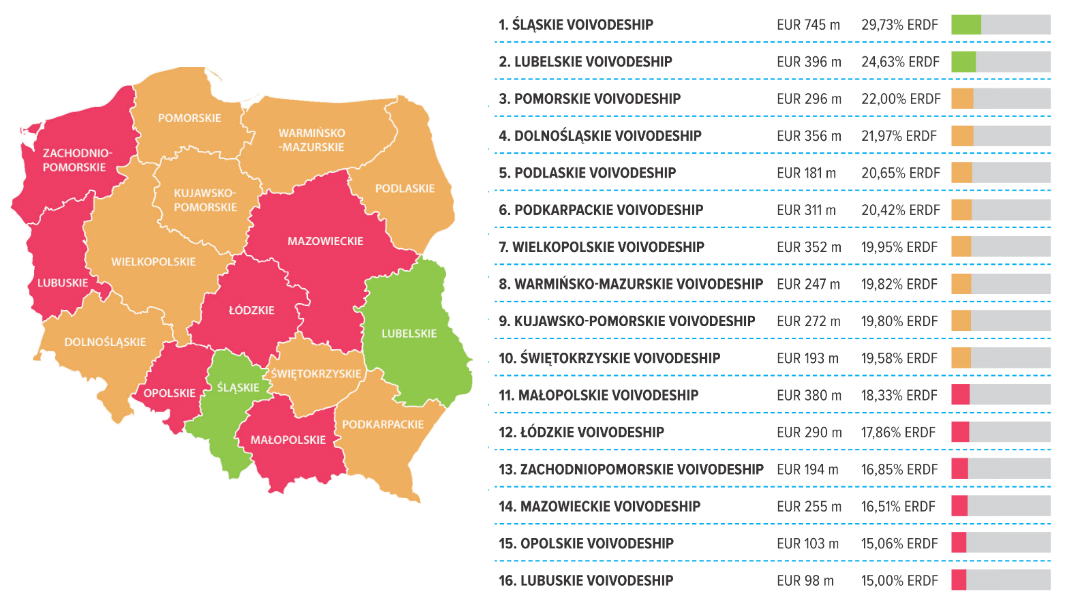Poland is currently in the final stages of planning how European funds under EU Cohesion Policy for 2014-2020 will be invested. Yet, beyond the national level, also Poland’s 16 regions (voivodeships) are about to conclude negotiations with the European Commission about the final shape of the Regional Operational Programmes (ROPs).
The results will show whether Poland’s regions are on the path to take full advantage of the potential of EU funds’ for the country’s sustainable development – a potential that is not to be underestimated. More than half of the EUR 9 billion that are earmarked for the low-carbon economy in Poland will be allocated and managed by the regional authorities. (For comparison, the total allocations of Cohesion Policy 2014-2020 for Bulgaria is EUR 7.59 billion, for Croatia EUR 8.61 billion.)
Bankwatch and Polish Green Network analysed the final drafts of the ROPs as they were presented to the European Commission. The analysis shows how ambitious (or not) the Polish regions are to invest in a low-carbon economy, in particularly when it comes to renewable energy and energy efficiency in residential buildings.
Report: Recommendations for the last state of programming of EU Regional Funds 2014-2020 for energy projects (pdf)
An important indicator is whether ordinary Polish households will be able to benefit from EU funds, for example through lower energy bills and greater security of energy supply. For smaller, localised investments, such as improving the energy standard in residential buildings or the production of citizen-owned energy from small renewables installations, the decisions made by the regional authorities will be essential.

Map: Allocation of funds for the thematic objective 4 on low-carbon economy as percentage of the total allocation of the European Regional Development Fund (ERDF) – Click image for full size
As the map above shows the level of ambition shown by Polish regions varies significantly.
While Śląskie in the South of Poland plans to spend almost 30 per cent of its European Regional Development Plan funds for low-carbon economy measures, there are many regions who keep the allocations close to the minimum 15 per cent, prescribed by the Polish Partnership Agreement.
While indicating the overall importance placed on the low-carbon economy objective by different regions, the map does not show their spending priorities within this area.
Energy efficiency in residential buildings
Going into more detail, one of the key elements we evaluated [1] was the availability of funding for energy efficiency in housing. The residential housing sector in Poland consumes over 30 per cent of all energy used in the country. The generally very poor energy standard of buildings resembles that of the 1970s in Western Europe and means a huge waste of energy and heat.
These losses could be avoided thanks to investments in deep retrofitting, estimated to result in up to 70 per cent energy savings.

Looking at the Regional Operational Programmes, the allocations for improving energy efficiency in residential buildings are alarmingly low in relation to the entire amount of funds intended to support a low-carbon economy, and even more so in relation to the total ERDF allocation in a given region (see graph).
According to our analysis, the public sector seems to have priority in the regional spending plans with more than twice as much funds allocated to improving energy efficiency in state and municipality-owned buildings than in residential houses.
Yet, it is especially in residential buildings where energy efficiency measures should get priority funding given that such investments are more difficult to undertake for private households who — in contrast to public institutions — do not have sufficient financial resources or access to subsidies and preferential loans.
Investments in retrofitting multifamily houses could significantly alleviate the financial burden faced by many Polish families and improve their quality of life. Research by the Polish Institute for Sustainable Development and the Warsaw Institute for Economic Studies shows that Polish households spend on average around 15 per cent of their disposable incomes on energy bills. According to another research paper (pdf) on energy poverty in the EU, more than 20 per cent are unable to afford comfortable temperature levels at home during the winter.
What’s next?
Once negotiations with the European Commission are finalised, it will be up to the regions themselves to prepare the more detailed implementation documents that outline exactly who will be able to apply for funding from the EU budget, for what kind of project and on what terms.
Our report “Green Energy for All: Six recommendations for the last stage of programming of EU regional funds 2014-2020 for energy projects” contains some key demands for the last, crucial stage of the EU funds programming, and recommendations on how to make them reality.
These recommendations regard:
- allowing for deep retrofitting of residential buildings,
- supporting RES microinstallations and prosumer energy,
- investing in renewables to improve air quality in Polish cities,
- financing environmental education and information campaigns,
- ensuring high biodiversity protection standards in energy-related projects,
- providing support for community energy and partnerships.
We call on Polish voivodeships to show ambition, go for quality and to invest rather than just spend.
Notes
1. The other elements are prosumer renewable energy, air quality, environmental education, biodiversity protection and communities and partnerships in the energy sector.
Never miss an update
We expose the risks of international public finance and bring critical updates from the ground – straight to your inbox.
Institution: EU Funds
Theme: Energy & climate
Location: Poland
Tags: Cohesion Policy | Operational Programme | Polish regions | Regional Funds | allocations | energy | energy efficiency | low-carbon | renewables | retrofits

